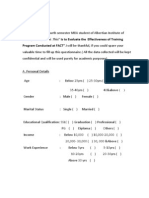Lesson 1 B.mathematics
Uploaded by
Christine Joy CalupigLesson 1 B.mathematics
Uploaded by
Christine Joy CalupigLesson 1: FRACTIONS: LOOKING BACK
Lesson Objectives:
At the end of the lesson, the students should be able to:
1. Demonstrate an understanding of fractions.
2. Recall types of fractions they have learned.
3. Explain how fractions operate when the unit referred to is a group or a class.
Pre-assessment (Activity No. 1)
A. Express the following as fraction of the units indicated:
1. 6 as part of a dozen - 6/12 or ½ 6. 500 pounds as part of a ton –
2. 8 weeks as part of a month – 5/8 500/1000 or ½
or ½ 7. 5 years as part of a decade –
3. 25 years as part of a century – 5/10 or ½
25/100 or ¼ 8. 6 hours as part of a day – 6/24 or
4. 2 quarts as part of a gallon – 2/4 1/4
or ½ 9. 1 inch as part of a foot – 1/12
5. 7 days as part of a week – 7/7 or 10. 5 as part of an eight-member
1 team - 5/8
B. A class is composed of 30 students. There are 20 girls and 10 boys. What fraction of
the class are girls? Boys? Ans. 20/30 or 2/3 and 10/30 or 1/3.
FRACTION
A fraction represents a part of a whole
NUMERATOR
Is the number above the fraction bar
It shows how many parts of the whole are called for
DENOMINATOR
Is the number below the fraction bar
It shows into how many parts a whole is divided
FRACTION BAR or VINCULUM – indicates division
THREE TYPES OF FRACTIONS:
1. Proper Fractions – fractions that less that a unit (ex. ½ and ¼)
2. Improper Fractions – fractions express equal to or greater than a unit (ex. 3/3
and 18/11)
3. Mixed Fractions – consists of whole number and a fraction (1 1/3 (read as one
and one-third)
Let’s share ideas (Activity No. 2)
1. Joey has five tools he uses in his carpentry shop. Two of the tools are hammers?
What fraction of the tools are hammers? Ans. 2/5
2. The ABM 11 A class spent P 820.00 for their party. This is 2/3 of the money they
collected. How much money did they collect? What part of the total collection
was left? How much is it? Ans. 3 times 820 divide 2 equals 1230, 1/3 & 410
3. Ceejhay sells rice to stores. She has a total of 125 cavans that she plans to
distribute to three stores. If she gives 1/5 of what she has to store A, can she
divide the remaining equally to stores B and C? How many will store A and store
B get? Ans. A- 1/5 (25), B- 50, C- 50 (125-25=100/2=50)
Lesson Summary (p.5)
Quiz (True or False-1-5)
1. T
2. F
3. T (8/5 = 1 3/5 > 7/6 = 1 1/6)
4. T (4=4)
5. F (2/3 = 0.67 > 4/8 = 0.50)
You might also like
- Chapter 3 The New Role of Human ResourcesNo ratings yetChapter 3 The New Role of Human Resources9 pages
- Statement of Financial Position - PPT - Accounts TitlesNo ratings yetStatement of Financial Position - PPT - Accounts Titles23 pages
- Suneeta Monga, Diane Benoit - Assessing and Treating Anxiety Disorders in Young Children - The Taming Sneaky Fears Program-Springer International Publishing (2018)No ratings yetSuneeta Monga, Diane Benoit - Assessing and Treating Anxiety Disorders in Young Children - The Taming Sneaky Fears Program-Springer International Publishing (2018)228 pages
- MODULE 2: Introduction To Financial ManagementNo ratings yetMODULE 2: Introduction To Financial Management6 pages
- Topic 1: Scope and Role of Financial ManagementNo ratings yetTopic 1: Scope and Role of Financial Management4 pages
- Word Problem Statement of Comprehensive Income0% (4)Word Problem Statement of Comprehensive Income1 page
- Chapter 1 - Introduction To Financial Management100% (1)Chapter 1 - Introduction To Financial Management28 pages
- Lesson 1 The Statement of Financial Position100% (1)Lesson 1 The Statement of Financial Position11 pages
- Mas M 1404 Financial Statements AnalysisNo ratings yetMas M 1404 Financial Statements Analysis22 pages
- First Quarter Test Grade 12: Fundamental of ABM-2No ratings yetFirst Quarter Test Grade 12: Fundamental of ABM-22 pages
- Module 5 - Statement of Changes in Equity PDFNo ratings yetModule 5 - Statement of Changes in Equity PDF7 pages
- Cash Management and Working Capital ReviewerNo ratings yetCash Management and Working Capital Reviewer2 pages
- Module 4 System of Linear Equations and InequalitiesNo ratings yetModule 4 System of Linear Equations and Inequalities29 pages
- Module 2. Cost Concept, Classification & BehaviorNo ratings yetModule 2. Cost Concept, Classification & Behavior16 pages
- Module 6 Ratio Analysis and InterpretationNo ratings yetModule 6 Ratio Analysis and Interpretation9 pages
- I. Activity/Exercises 1:: Apply It in Real LifeNo ratings yetI. Activity/Exercises 1:: Apply It in Real Life3 pages
- Case Study On Financial Fraud in The US Treasury DepartmentNo ratings yetCase Study On Financial Fraud in The US Treasury Department44 pages
- Markup and Markdown: Mr. Christian Rae D. Bernales, LPTNo ratings yetMarkup and Markdown: Mr. Christian Rae D. Bernales, LPT7 pages
- Sol. Man. - Chapter 1 - The Accounting Process - Ia Part 1aNo ratings yetSol. Man. - Chapter 1 - The Accounting Process - Ia Part 1a6 pages
- The Three Core Values and Objectives of DevelopmentNo ratings yetThe Three Core Values and Objectives of Development3 pages
- Corporation Transactions After FormationNo ratings yetCorporation Transactions After Formation14 pages
- Commissions - Sample Math Practice Problems: Complexity 1, Mode SimpleNo ratings yetCommissions - Sample Math Practice Problems: Complexity 1, Mode Simple6 pages
- FABM1 - Module 4 Accounting Concepts and PrinciplesNo ratings yetFABM1 - Module 4 Accounting Concepts and Principles5 pages
- The Meralco Electric Company Is A Perfect Example of67% (3)The Meralco Electric Company Is A Perfect Example of1 page
- Management Science Module 8 - Break - Even Point AnalysisNo ratings yetManagement Science Module 8 - Break - Even Point Analysis7 pages
- Culminating Activity Proposal (Entrep 2018)No ratings yetCulminating Activity Proposal (Entrep 2018)2 pages
- Applied Economics-Summative Test-Edited PDFNo ratings yetApplied Economics-Summative Test-Edited PDF1 page
- Name: - Date: - Grade & Section: - ScoreNo ratings yetName: - Date: - Grade & Section: - Score1 page
- Abm Company Comparative Balance Sheet December 31, 2016, December 31, 2017No ratings yetAbm Company Comparative Balance Sheet December 31, 2016, December 31, 20174 pages
- 1 Should Examinations Be Replaced With Other Forms of AssessmentNo ratings yet1 Should Examinations Be Replaced With Other Forms of Assessment3 pages
- 6 Difference Between Creativity and InnovationNo ratings yet6 Difference Between Creativity and Innovation11 pages
- Workbook The Conscious Outlaw Mike DiamondNo ratings yetWorkbook The Conscious Outlaw Mike Diamond17 pages































































































